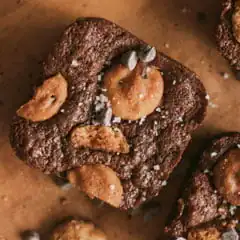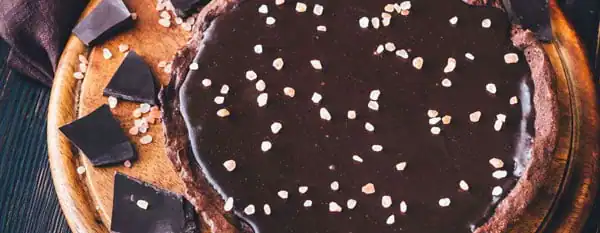Himalayan salt has gained popularity in recent years for its unique pink color and alleged health benefits. While it is commonly used in cooking and seasoning, it is also becoming a popular ingredient in baking. Bakers are discovering the versatility of Himalayan salt and its ability to enhance the flavor of both sweet and savory baked goods.
When it comes to baking, Himalayan salt is often preferred over other types of salt due to its natural mineral content. Unlike regular table salt or even kosher salt, Himalayan salt contains a variety of minerals such as iron and potassium that can contribute to a more complex flavor profile.
The use of Himalayan salt for baking is also becoming popular due to its unique texture and crunch. When used as a finishing salt, it can add an extra layer of flavor and texture to baked goods such as scones, bread, and cookies. It can also be used as a cooking surface, such as a salt block, for grilling meats and vegetables.
Can You Use Himalayan Salt for Baking?
Himalayan salt can be used for baking but it’s important to know that is has some subtle differences, like flavor profile, that will mean making adjustments to measurements to get the desired flavor.
Himalayan salt has a different flavor profile than regular table salt. It has a slightly more floral taste and a more complex mineral composition.
This means that if you substitute Himalayan salt for regular salt in a baking recipe, it may alter the taste slightly. It’s a good idea to experiment with small quantities first to see how it affects the flavor. Salt that is mixed into batter may not change the overall flavor very much, but salt that is used for finishing (on top of cookies, brownies, etc.) can have a bigger impact.
Some bakers prefer to use slightly less Himalayan salt due to its somewhat stronger flavor. Again, it’s best to experiment and see what works for your taste buds.
In terms of quantity vs. taste, it’s important to remember that Himalayan salt is still salt. Using too much salt, regardless of the type, can overpower the other flavors in your baked goods. It’s always best to follow the recipe’s instructions and adjust to taste.
Himalayan salt can be used in both sweet and savory baked goods. In sweet dishes, it can add a subtle depth of flavor that pairs well with chocolate and caramel. In savory dishes, it can enhance the flavor of cheese or butter.
Can You Use Himalayan Salt for Baking Bread?
Himalayan salt can be used for baking bread. However, it is important to note that the texture and flavor of the bread may be slightly different than if regular table salt were used.
When using Himalayan salt for baking bread, it is recommended to use a fine grind to ensure even distribution throughout the dough. It’s important to note that Himalayan salt may not provide the same level of rise as regular table salt, so adjustments to the recipe may be necessary. Grinding methods include ceramic grinders, or a good old fashioned mortar and pestle.

One of my favorite uses for using Himalayan salt for baking is making Pretzels! Instead of using kosher salt on top of the pretzels, use pink Himalayan salt that is ground to be about half the size of typical kosher salt. The Pretzels will burst with flavor!
In addition to pretzels, here are some types of bread that can be made with Himalayan salt:
- Baguette: Baguette is a French bread that is known for its crispy crust and soft interior. Himalayan salt can be added to the dough to enhance the flavor of the bread. For a non-traditional presentation, you can also sprinkle a bit of Himalayan salt on top of the loaves as you take them out of the oven. Baguette is best served warm with butter.
- Pita Bread: Pita bread is a Middle Eastern bread that is perfect for sandwiches and dipping in hummus. Himalayan salt is typically best when added to the dough.
- Egyptian Bread (Aesh Baladi): Aesh Baladi is a traditional Egyptian bread that is made with flour, water, yeast, and salt. Himalayan salt can be used instead of regular salt to give the bread a unique flavor.
- Moroccan Bread (Msemen): Msemen is a Moroccan bread that is made with semolina flour and is usually served with honey or jam. Himalayan salt can be added to the dough to enhance the flavor.
- Banana Bread: Banana bread is a sweet bread that is perfect for breakfast or as a snack. Himalayan salt can be added to the batter to ‘pop’ the other flavors in the bread.
- Zucchini Bread: Zucchini bread is a healthy bread that is made with grated zucchini. Himalayan salt can be added to the batter to enhance the other flavors. While you’re at it, sprinkle a little cinnamon in there too!
- Focaccia Bread: Focaccia bread is an Italian bread that is topped with olive oil, herbs, and sometimes cheese. Himalayan salt can be added to the dough to give the bread a unique flavor.
- Multigrain Bread: Multigrain bread is a healthy bread that is made with a variety of grains. Himalayan salt can be added to the dough to enhance the flavor of the bread.
- Rye Bread: Rye bread is a dense bread that is made with rye flour. Himalayan salt and cracked fennel seed on top of Rye bread is delicious.
- Sourdough Bread: Sourdough bread is a bread that is made with a sourdough starter instead of yeast. Himalayan salt can be added to the dough to enhance the flavor of the bread.
Can You Use Himalayan Salt for Baking Cookies?
Himalayan salt can be used for baking cookies but the texture and flavor may be slightly different than if regular table salt were used. Himalayan salt has a complex flavor profile that can add a unique twist to cookies.
When using Himalayan salt for baking cookies, it is recommended to use a fine grind and to adjust the amount used based on personal preference. Some bakers have reported that using Himalayan salt in place of regular salt can result in a crumbly texture, so experimentation may be necessary to achieve the desired results. Remember that the role of salt in baking a cookie is to bring out the other flavors in the cookie batter – not to make a salty cookie!
Here are some popular cookie recipes that can benefit from the use of Himalayan salt for baking:
- Chocolate Chip Cookies: Chocolate chip cookies are a classic favorite that can be enjoyed by all ages. Adding a pinch of Himalayan salt to the cookie dough can help balance out the sweetness of the chocolate chips and create a more complex flavor. Using unsalted butter in the dough can also help control the overall saltiness of the cookie.
- Sugar Cookies: Sugar cookies are a versatile treat that can be decorated with icing or enjoyed plain. Adding a small amount of Himalayan salt to the dough can help bring out the sweetness of the sugar and create a more balanced flavor.
- White Chocolate Macadamia Nut Cookies: White chocolate macadamia nut cookies are a decadent treat that can benefit from the use of Himalayan salt. Adding a pinch of salt to the dough can help balance out the sweetness of the white chocolate and create a more complex flavor.
- Oatmeal Raisin Cookies: Oatmeal raisin cookies are a hearty treat that can be enjoyed any time of day. Adding a small amount of Himalayan salt to the dough can help bring out the nuttiness of the oats and create a more balanced flavor. Using salted butter in the dough can also add a subtle saltiness to the cookie.
- Peanut Butter Cookies: Peanut butter cookies are a classic favorite that can be enjoyed by all ages. Adding a pinch of Himalayan salt to the dough can help balance out the sweetness of the peanut butter and create a more complex flavor. Using unsalted butter in the dough can also help control the overall saltiness of the cookie. Also remember that the peanut butter itself can have some salt in it, so be conservative in how much extra salt you add to your batter.
- Snickerdoodle Cookies: Snickerdoodle cookies are a cinnamon-sugar treat that can be enjoyed any time of day. Adding a small amount of Himalayan salt to the dough can help bring out the warmth of the cinnamon and create a more balanced flavor. Snickerdoodle Cookies get their unique flavor from Cream of Tarter (potassium bitartrate for the chemistry fans), which is considered an ‘Acid Salt’. It is a byproduct of wine fermentation, and the salt was originally discovered because it accumulated on the outside of wine fermentation barrels.
- Double Chocolate Cookies: Double chocolate cookies are a rich treat that can benefit from the use of Himalayan salt. Adding a pinch of salt to the dough can help balance out the sweetness of the chocolate and create a more complex flavor. Using unsalted butter in the dough can also help control the overall saltiness of the cookie. Salt really brings out the ‘chocolat-i-ness’ of baked goods, so a very light sprinkle of Himalayan salt on top of the cookies can be a taste sensation!
- Shortbread Cookies: Shortbread cookies are a buttery treat that can be enjoyed any time of day. Adding a small amount of Himalayan salt to the dough can help bring out the richness of the butter and create a more balanced flavor. Even though many recipes for shortbread cookies specify unsalted butter, I like to use salted butter in the dough because I think you get a better salt distribution through the entire cookie. I cut back on whatever amount is specified for table salt instead.
Salt in Salted Butter
One standard stick of butter contains between 250mg and 350mg of sodium, depending on the brand. Depending on the grain size of your Himalayan salt, a teaspoon averages 2000mg of sodium. That means that one stick of butter is adding less than 1/4 teaspoon of salt. Small amounts! The type of butter you choose might be affected by how carefully you want to measure your salt. No wonder some recipes specify ‘a pinch’ of salt.

Be sure not to forget brownies! Caramel and Himalayan salt as a topping on chocolatey brownies is one of my favorite combinations.
A Guide To Baking With Himalayan Salt
Which Salt Is Best for Baking
When it comes to baking, the type of salt you use can make a big difference in the flavor and texture of your baked goods. Himalayan salt is a popular choice among bakers because of its unique flavor profile and mineral content.
However, not all Himalayan salt is created equal. Look for fine-grain Himalayan salt that is specifically labeled for baking. If your salt is coarse-grained, be sure to crush it in a grinder or mortar/pestle.
Kosher salt is also a big favorite of serious cooks, and this seems to extend to baking. I like using kosher salt within dough and Himalayan salt for finishing salt where you most benefit from the mineral flavor and crystal texture. Depending on the amount of moisture in your dough, you may also want to grind up your kosher salt grains – or pre-dissolve them with your liquid ingredients before adding your dry ingredients.
Benefits of Baking With Himalayan Salt
Himalayan salt is known for its high mineral content, which includes calcium, magnesium, and potassium. These minerals can help balance the pH levels in your baked goods, resulting in a more even rise and a better texture.
The unique flavor can add a subtle complexity to your baked goods that regular table salt cannot.
Comparing Kosher Salt vs. Himalayan Salt Baking
Kosher salt and Himalayan salt are both popular choices for baking, but they have some key differences. Kosher salt is a coarse salt that is less dense than Himalayan salt, which means that you will need to use more kosher salt (by volume) to achieve the same level of saltiness as Himalayan salt. If you are the kind of baker that weighs all of your ingredients, then there is little difference between the two salts (in sodium per gram).
Additionally, kosher salt does not have the same mineral content as Himalayan salt, which can affect the flavor and texture of your baked goods. Kosher salt is a type of coarse salt that is traditionally used in Jewish cuisine. It is made by compacting large crystals of salt together, which gives it a unique texture and flavor.
Himalayan sea salt, on the other hand, is a type of rock salt that is mined from the Himalayan mountains. It is known for its pink color and high mineral content.
Why Is Kosher Salt Preferred By Chefs
Many chefs prefer kosher salt because of its texture and flavor. The larger crystals of kosher salt make it easier to control the amount of salt that is added to a dish, and the texture can add a nice crunch to certain dishes.
Additionally, kosher salt does not contain any additives, which can be a concern with some types of table salt.

Tips for Using Himalayan Salt for Baking
Himalayan salt is a versatile ingredient that can be used in both sweet and savory baking recipes. Here are some tips for using Himalayan salt in your baking:
Use the Right Type of Salt
When using Himalayan salt for baking, it’s important to use the right type of salt. Fine-grain Himalayan salt is best for baking because it will dissolve easily and distribute evenly throughout the dough or batter. Other options include reducing the grain size through use of a ceramic grinder or a mortar and pestle.
Measure Carefully
Himalayan salt is more flavorful than regular table salt, so you’ll need to use less of it in your recipes. Be sure to measure carefully and adjust the amount of salt based on your personal taste preferences. Another option is to weigh your salt with a kitchen scale (it needs to measure fairly accurately in grams to use this method).
Add a Crunch
Himalayan salt can add a delicious crunch to baked goods. Try sprinkling a little of the coarse-grains on top of cookies, brownies, or bread before baking for a tasty and unique twist.
Experiment with Sweet and Savory Recipes
Himalayan salt is a versatile ingredient that can be used in both sweet and savory recipes. Try using it in cookies, cakes, and other sweet treats, as well as in bread, pizza dough, and other savory dishes.
Try Different Colors
Himalayan salt comes in a variety of colors, from white to pink to red. Each color has a slightly different flavor profile, so don’t be afraid to experiment with different colors, especially when your baked goods are a very light color.
Pretzel photo by David Nuescheler. Brownie photo by Ayoub Moukhliss.







